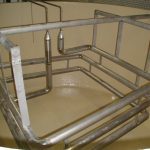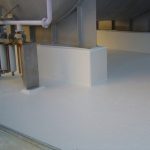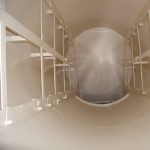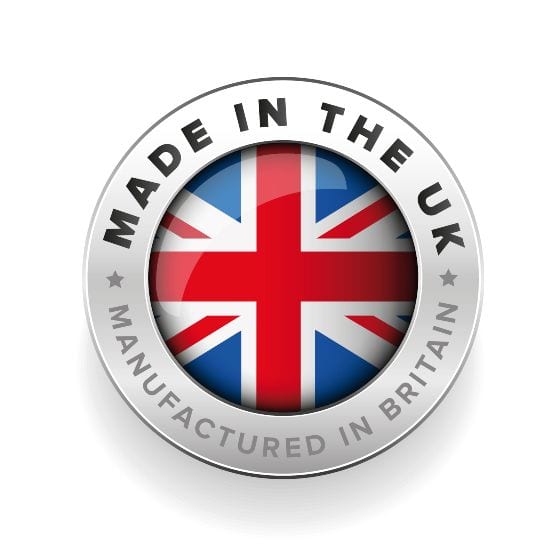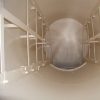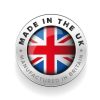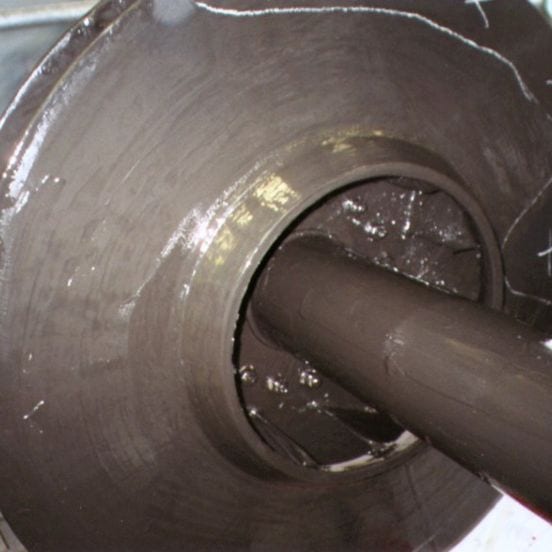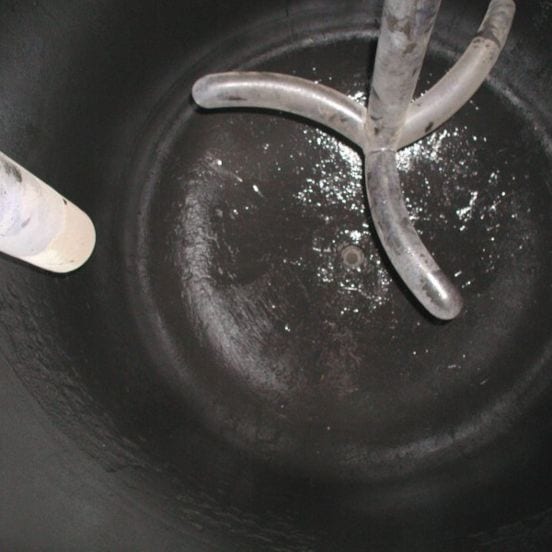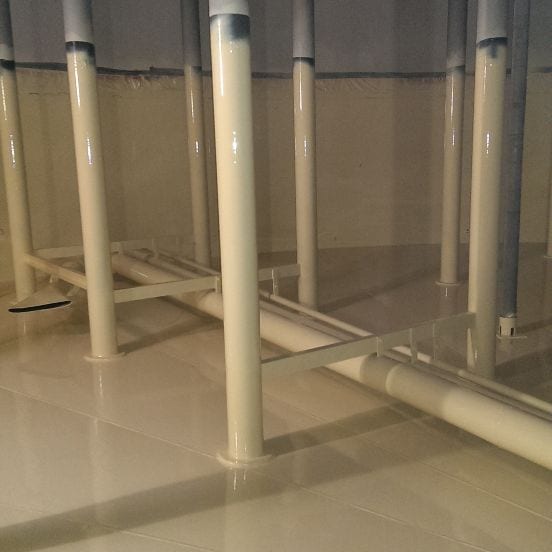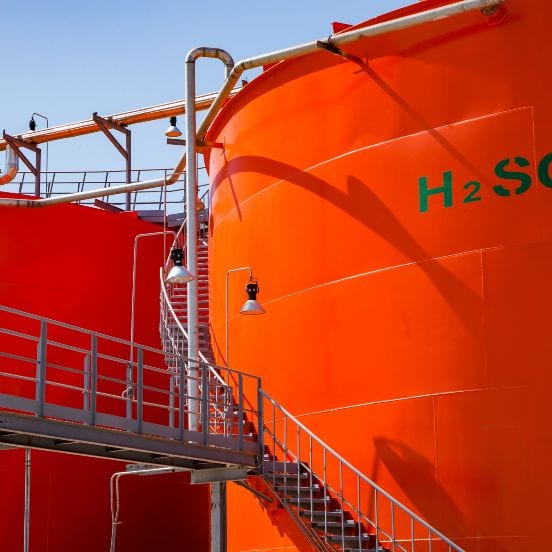Description
M-CHEM 401 – Acid Resistant High Temperature Coating – Extended Cure
Is an Extend Cure Version of M-CHEM 400 the material is a solvent free coating utilising the latest novolac polymer technology. The material provides excellent chemical protection for applications subject to high service temperatures.
The product is designed for the long-term protection of steel and concrete surfaces subject to constant chemical immersion at elevated temperatures.
Once cured the material is capable of withstanding service temperatures up to 90°C continuous immersion, dependent on chemical contact.
M-CHEM 401 is proven to protect against 98% Sulphuric Acid at 75°C, 36% Hydrochloric Acid at 50°C and 40% Phosphoric Acid at 60°C.
Typical Uses
- Tank lining & process vessels
- Lining for Chemical drains and channels
- Lining for Internal Pipe Surfaces
- Protection for Chemical Sumps
- Lining for Pressure Vessels
Please contact us to discuss your project before purchasing this material to confirm suitability.
Application Guide
- All oil and grease must be removed from the surface using an appropriate cleaner such as MEK or similar type solvent.
- All surfaces must be abrasive blasted to ISO 8501/4 Standard SA2.5 (SSPC SP10/ NACE 2) minimum blast profile of 75 microns using an angular.
- Once blast cleaned the surface must be degreased and cleaned using MEK or similar type solvent.
- All surfaces must be coated before gingering or oxidation.
PLEASE NOTE: Soluble salt contaminated surfaces the substrate must be pressure washed with clean water and checked for salt contamination this process may need to be repeated several times.,
Existing Concrete
- If the concrete surface is contaminated, pressure wash using clean water.
- Once the concrete is dry, lightly abrasive blast or scarify taking care not to expose the aggregate.
- Clean all dust and debris from the surface and prime with M-PRIME 100 – Low Viscosity Epoxy Concrete Primer or M-PRIME 104 – Damp Tolerant Concrete Primer
- Apply either primer at target WFT of 150 microns, leave to cure for 3 hours (20°C) before overcoating.
New Concrete
- Allow new concrete to cure for a minimum of 21 days and treat to remove any surface laitance.
- Check the moisture content of the concrete prior to coating (8% moisture content or below).
- Lightly scarify the surface taking care not to expose the aggregate.
- Clean all dust and debris from the surface and prime with M-PRIME 100 low viscosity epoxy primer.
- Apply either primer at 150 microns WFT, leave to cure for 3 hours 20°C before overcoating.
Prior to mixing please ensure the following:
- The base component is at a temperature between 15-25°C.
- Do not apply the material when the ambient or substrate temperature is below 10°C or less than 3°C above dew point.
- Transfer the contents of the Activator unit into the Base container.
- Using a low speed electric paddle mixer, mix the 2 components until a uniform material free of any streaks is achieved.
- Once mixing is complete, use the mixed paste as soon possible.
Use all mixed material within 20-25 minutes at 20°C.
Brush or Roller Applications
- Pour the mixed material into a paint kettle or paint tray (this will maximise the usable life)
- Using a 50mm wide synthetic brush, stripe coat all edges, joints, corners and equipment with the mixed material. The stripe coat must be approximately 100mm wide, at 500 microns wet film thickness.
- Once the stripe coat has cured sufficiently and is capable of being overcoated, apply the 1st coat of mixed product to all surfaces at 500 microns wet film thickness.
- Once the 1st coat of material has cured sufficiently, approximately 8 hours at 20°C, apply a 2nd coat of material to all surfaces at 500 microns wet film thickness.
Spray set up & Application
- Spray application should be carried out by heated plural feed spray rig.
- The temperature of the base component should be kept around 35°C.
- Spray pressure of 3600psi and a tip size of 19-23 thou should be used.
- Using a 50mm wide synthetic brush, stripe coat all edges, joints, corners and equipment with the mixed material. The stripe coat must be approximately 100mm wide, at 400 microns wet film thickness.
- Once the stripe coat has cured sufficiently and is capable of being overcoated, apply M-CHEM 401 to all surfaces at 1000 microns wet film thickness.
To enhance the properties of this material, post curing will be required.
- Allow the product to cure for at least 4 hours at 20°C.
- Raise the coating and substrate temperature progressively to 60 – 80°C for up to 8 hours.
Post curing will result in improved mechanical, thermal and chemical resistance properties.
| Appearance | Base Activator Mixed | Grey/ red paste Amber fluid Grey/ red Liquid |
| Mixing Ratio | By Weight By Volume | 4.35:1 3.25:1 |
| Density | Base Activator Mixed | 1.41 1.05 1.33 |
| Solids Content | 100% | |
| Sag Resisitance | Nil at | 500 microns |
| Usable Life | 10°C 20°C 30°C | 90 minutes 45 minutes 22 minutes |
| Theoretical Coverage | The material should be applied in 2 coats at 500 microns wet film thickness | 2 sqm /ltr |
| Cure Times | Minimum overcoating time at 20°C Maximum overcoating time at 20°C Water/ sea water immersion at 20°C Chemical immersion at 20°C | 8 hours 24hours 96 hours 7 days |
| Storage Life | Unopened and stored in dry conditions (15-30°C) | 5 years |
| Adhesion | Tensile Shear to ASTM D1002 on abrasive blasted mild steel with 75 micron profile | 201kg/cm² 2855psi |
| Compressive Strength | Tested to ASTM D 695 | 901kg/cm² (12800psi) |
| Corrosion Resistance | Tested to ASTM B117 | 5000 hours |
| Flexural Strength | Tested to ASTM D790 | 810kg/cm² (11500psi) |
| Hardness | Shore D to ASTM D2240 | 20°C 86 100°C 85 150°C 72 |
| Heat Distortion | Tested to ASTM D648 at 264psi fibre stress | 20°C Cure 60°C 100°C Cure 98°C 150°C Cure 112°C |
| Heat Resistance | Suitable for use in immersed conditions at temperatures up to: Suitable for use in dry conditions at temperatures up to dependant on load: | 90°C 200°C |
| Enhanced Chemical Resistance when post cured Acetic Acid 10% at 50˚C Ethanol 100% at 75˚C Sulphuric Acid 98% at 75˚C Sulphuric Acid 25 -75% at 90˚C Hydrochloric Acid 10-36% at 50˚C Phosphoric Acid 20-40% at 60˚C Nitric Acid 5% at 50˚C Sodium Hydroxide 40% at 90˚C Sodium Chloride 20% at 90˚C | Chemical Resistance tested at 20˚C Chromic 10% Hydrobromic 40% Hydrochloric 36% Nitric 10% Nitrous 10% Phosphoric 75% Sulphuric 98% Acetic 10% Carbonic 30% Citric 30% Folic 20% Formic 10% Lactic 10% Ammonium hydroxide 30% Potassium hydroxide 20% Sodium hydroxide 40% Sodium Bisulfate 40% | Chemical Resistance tested at 20˚C Butanol 100% Ethylene glycol 100% Hexanol 100% Propylene glycol 100% Aniline 100% Diethanolamine 100% Hydrazine 100% Methylamine 40% Cyclohexane 100% Hexane 100% Octane 100% Benzene 100% Naphtha 100% Toluene 100% Xylene 100% |
Please contact us to discuss your project before purchasing this material to confirm suitability.

